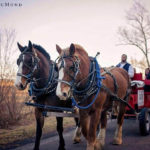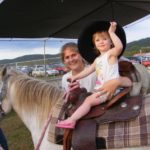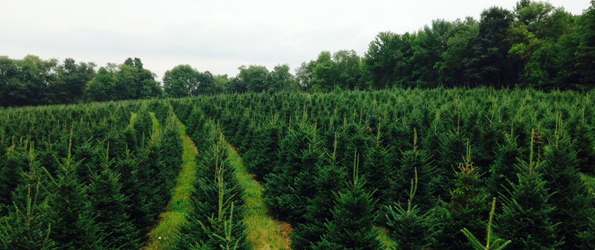
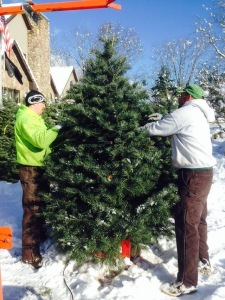 Each fall, the Kalie’s can be found preparing the fields for spring planting. Nutrient content, PH levels, drainage, and cover crops are adjusted in the fields being prepared for the next crop of trees. Several thousand bare root seedlings are planted each year. Most seedlings are about 8”-12” tall, and are already 3 or 4 years old when they arrive from the nursery. We plant by hand or by machine, depending on how wet it is in early spring.
Each fall, the Kalie’s can be found preparing the fields for spring planting. Nutrient content, PH levels, drainage, and cover crops are adjusted in the fields being prepared for the next crop of trees. Several thousand bare root seedlings are planted each year. Most seedlings are about 8”-12” tall, and are already 3 or 4 years old when they arrive from the nursery. We plant by hand or by machine, depending on how wet it is in early spring.
Once planted, the trees are fertilized and watered as necessary depending on weather conditions. Emerging weeds in the rows are controlled so that the nutrients and moisture are left for the young trees. Cover crops are also established between rows to control erosion.
During the growing season we mow the grass between the rows of trees on a regular basis. Mowing, along with proper weed control, allows the lower branches to get sunlight for full growth and development. Trees along the edges of the field are cut for firewood, so all the Christmas trees can have full sunlight.
During late summer each year, every single tree on the farm has to be sheared to make it look its best for you. We cultivate the preferred “Christmas tree shape” by training a single leader each year, removing “doubles” and tying up leaders to keep a straight stem growing. This enormous undertaking fills up a lot of weekends and evenings, but results in a much fuller, conically shaped tree desired by most people.
In the fall we are usually still trying to finish up the shearing, keeping the tree rows free of weeds, and continuing to mow the fields. More fertilizer is applied to give the trees a beautiful deep green color, as well as help with needle retention once the tree is cut down.
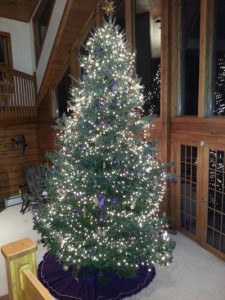 November and December are incredibly busy as we harvest and sell trees. Trees are placed on our tree shaker after harvest to dislodge old needles, weeds, and debris so you will have a clean tree. Excess bottom branches are cut off to make it easier to put the tree into a stand, then the tree is baled (wrapped with twine) to make it compact for transporting and to protect its delicate branches. It gets even more interesting when there is snow on the ground in the fields.
November and December are incredibly busy as we harvest and sell trees. Trees are placed on our tree shaker after harvest to dislodge old needles, weeds, and debris so you will have a clean tree. Excess bottom branches are cut off to make it easier to put the tree into a stand, then the tree is baled (wrapped with twine) to make it compact for transporting and to protect its delicate branches. It gets even more interesting when there is snow on the ground in the fields.
January and February might be the only time to catch our breath. By March, the ground begins to thaw and cycle continues. Then suddenly we are planting trees once again!
The average Christmas tree sold at Kalie’s Tree Farm has been growing in our fields for 8 years. That’s 8 years of filtering carbon dioxide and other pollutants to produce fresh, clean, oxygen rich air. One acre of young evergreens produces enough oxygen for 18 people!
For every tree sold, several more are planted as our business continues to grow, Thanks to You.
Benefits of a Real Tree
- Christmas tree farms help clean the air of dirt, smog and other pollutants. Experts say that trees will help slow down the greenhouse effect. Farms filter our water, absorb the runoff from large storms and help stop erosion.
- Not only are the farms helping to clean the air but they also act as homes for many animals. You can find turkeys, deer, rabbits and many beautiful birds living on many tree farms. The animals love the security of the farm. The tree farm is a place where nature lives together.
- Artificial trees are made in factories from plastic and metal. Some of these factories are overseas and produce large amounts of waste. After a few seasons, most people tire of their artificial tree and it ends up in a landfill. There, it may survive for centuries.
- Real trees are 100% biodegradable and can be recycled after Christmas.




